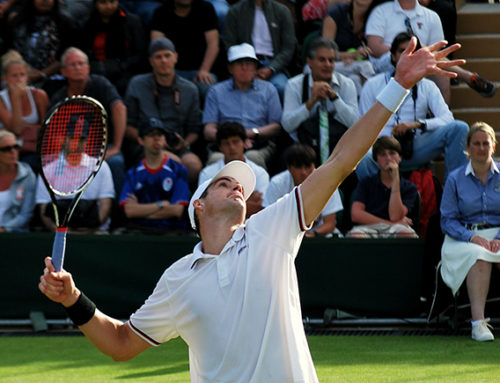In a recent college match Joe was outmatched at #6 singles. His opponent Nick knew it and played like he knew it. Nick went about the match like a man who had a quick job to take care of and Joe acted as though he didn’t want to inconvenience him too much. The pace was quick, and the first set was done 6-0 in record time. I had given Joe some tactical advice earlier in the set, but now it was time for some different advice altogether.
“This guy might beat you 6-0, 6-0. But let’s make it the longest, toughest 6-0, 6-0 of his life. He’s playing well, and you’re letting him run away with the match. When things are going badly, slow the pace of the match down. Make him stay out here. Stick around. If you stay out here long enough, you’re allowing time for things to change.”
I checked back a few games later, and Joe was winning the second set 3-2. While he would later go on to lose the set and the match, there was an important lesson in there for all competitive tennis players. Control the tempo of the match.
Fight On All Fronts
Sometimes we lose sight of the fact that a tennis match is in truth a battle. It is combat fought with tennis rackets and balls instead of swords and axes, and on a court instead of in an arena. When we enter the court to play the match, it is important that we learn to fight on all available fronts. This is not to say we play outside the rules, or argue with our opponents about things. Rather I am saying that we must ensure we are affecting the match in every way possible within both the letter and the spirit of the rules.
Too often people focus purely on the aspects of tennis that happen during the point, and ignore all of the important things that can happen between points. They focus on how well or poorly they are playing, and ignore the things that they can do to affect the quality of their opponent’s play. Because ultimately victory in tennis comes from one thing: playing better than your opponent on the day. It doesn’t matter whether or not you are playing well. What matter is whether or not you are playing better than your opponent.
Of all of these aspects, today we’re going to focus purely on match tempo.
What Is Match Tempo?
Match tempo ultimately comes down to two things.
1) The rate at which points are begun.
2) The length of each point.
To give a couple of examples of the first, Rafael Nadal is renowned for playing at a slow tempo between points. del Potro is another who plays at a slow clip. Examples of players who use a quick tempo would be Roger Federer and Andy Roddick. The tempo within the point itself can be harder to control, but Nadal also plays his points at a slow tempo. He is happy for long rallies dictated by heavy topspin shots. del Potro, for all his slow tempo between points employs a quick tempo during them, dictating play with big serves and hard, flat forehands.
Riding Out The Zone
Have you ever taken the court against an opponent who played unbelievably well and thought “they can’t keep this up for long?” The simple truth is that if they are normally close to your level and they’re absolutely killing you you’re probably right. Your opponent might well be in the elusive “zone”, where mental, physical and emotional peaks overlap creating ideal playing conditions. However most players cannot stay there forever, and a typical player might only be in the zone for a time measured more in minutes than hours.
So let’s assume our opponent is in the zone, and will stay there for around 30 minutes. Now comes the obvious: should we play as many points as possible during those 30 minutes, or as few as possible? Clearly we should play as few points as possible. Again we do so within the rules, but there is nothing in the rules that says we must play quickly when our opponent is playing well. The receiver must play at the pace of the server provided the server’s pace is reasonable. So if your opponent is playing out of his or her mind, take your time on your own serve. Use your 20-30 seconds between points (depending which rules you’re playing under) and your 90 seconds on changeovers. Don’t let them rush you on their serve either. Play at a reasonable pace, but there is nothing saying you must run between points. Play as few points as possible when your opponent is in the zone, and you can pick the pace up if you want to when they start playing worse.
Disrupting Their Rhythm
Everyone has conditions under which they play their best. Slow courts or fast courts. Hot or cold. Indoors or outdoors. Hard courts or clay courts. However there are factors that have as much if not more impact than most of these. Tempo plays a huge part in a player’s performance. Every player has a tempo at which, under most conditions on most days, they play better. As mentioned above Nadal plays at a very slow tempo. He has a lot of small rituals he performs between points (the infamous wedgie-picking being one of them). Additionally he seems to thrive when he has time to think his way through from point to point, and given the emotional energy he expends seemingly on each strike of the ball it’s no surprise he does well with a big recovery time between points.
By changing the tempo you can deny an opponent the chance to play at a pace that brings out their best. One of the interesting things is how often opponents can unconsciously match their opponent’s pace. As a serve and volleyer in college I played my best when I kept things moving along. Oftentimes on changeovers I would walk straight through without sitting down, pausing only for a gulp of water. I found opponents would decrease the time on their own changeovers often without realizing it. The physical sight of me standing on the court ready to play made them feel like they needed to be out there also.
When To Play At A Quick Tempo
Speed up the pace of play in the following situations:
– When you have the momentum. If you are on a roll and winning points, especially quickly, keep the time between points short.
– Play at a quick pace if you are on the offensive and your opponent is playing defensively. When are running more than you are and need the recovery time more than you do.
– Your opponent is dragging their feet between points. This shows they want a slower tempo and there’s no reason to give them what they want!
When To Slow The Tempo Down
Slow the pace of the match down under the following circumstances:
– When you are overmatched. A stronger opponent wants and expects to be off the court quickly. By keeping them on the court playing longer they might get frustrated by their own expectations and drop their level.
– When the run of play is against you. If you’re making unforced errors, or your opponent is forcing play and/or hitting winners, slow play down.
– When they are an attacking player and you are on the defensive. You need the recovery time, and even if you aren’t tired right now you might be in that third set and wished you’d taken more time earlier!
Final Thoughts
There’s that old adage: if you do what you’ve always done, you get what you’ve always gotten. If your match isn’t going the way you would like, it’s time for a change. Sometimes it isn’t a problem with your game plan. Sometimes you’re just playing right into your opponents tempo and letting him play at his pace which allows him to play his best tennis. There’s more than one way to skin a cat. Control the tempo of the match overall and it can help you control the points and hence the outcome.


